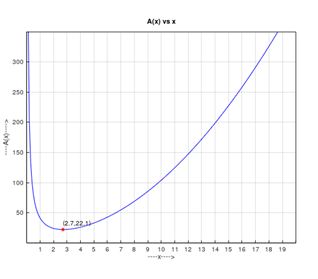
Concept explainers
26. Constructing an Open Box An open box with a square base is required to have a volume of 10 cubic feet.
(a) Express the amount A of material used to make such a box as a function of the length x of a side of the square base.
(b) How much material is required for a base 1 foot by 1 foot?
(c) How much material is required for a base 2 feet by 2 feet?
(d) Use a graphing utility to graph . For what value of x is A smallest?
To find:
a. To expresses the Amount of material used to make a open box with square base as a function of length of the side of the square base.
Answer to Problem 26AYU
Solution:
a.
Explanation of Solution
Given:
An open box with a square base is required to have a volume to 10 cubic feet.
Calculation:
a. To expresses the Amount of material used to make a open box with square base as a function of length of the side of the square base.
Let represent the side of the square base.
Let represent the height of the box.
Let represent the amount of material required for the box.
The volume of the box , where
Hence height .
Area of the base .
Area of side wall .
To find:
b. To find how much material is required for a base of 1 foot by 1 foot.
Answer to Problem 26AYU
Solution:
b. 41 sq feet
Explanation of Solution
Given:
An open box with a square base is required to have a volume to 10 cubic feet.
Calculation:
b. To find how much material is required for a base of 1 foot by 1 foot.
To find:
c. To find how much material is required for a base of 2 feet by 2 feet.
Answer to Problem 26AYU
Solution:
c. 24 sq feet
Explanation of Solution
Given:
An open box with a square base is required to have a volume to 10 cubic feet.
Calculation:
c. To find how much material is required for a base of 2 feet by 2 feet.
To find:
d. To graph and find value of where is smallest.
Answer to Problem 26AYU
Solution:
d.
Explanation of Solution
Given:
An open box with a square base is required to have a volume to 10 cubic feet.
Calculation:
d. To graph and find value of where is minimum.

From the graph, we can see that the is minimum when .
Chapter 2 Solutions
Precalculus Enhanced with Graphing Utilities
Additional Math Textbook Solutions
A First Course in Probability (10th Edition)
Elementary Statistics: Picturing the World (7th Edition)
Precalculus
Algebra and Trigonometry (6th Edition)
A Problem Solving Approach To Mathematics For Elementary School Teachers (13th Edition)
Basic Business Statistics, Student Value Edition
- Use the properties of logarithms, given that In(2) = 0.6931 and In(3) = 1.0986, to approximate the logarithm. Use a calculator to confirm your approximations. (Round your answers to four decimal places.) (a) In(0.75) (b) In(24) (c) In(18) 1 (d) In ≈ 2 72arrow_forwardFind the indefinite integral. (Remember the constant of integration.) √tan(8x) tan(8x) sec²(8x) dxarrow_forwardFind the indefinite integral by making a change of variables. (Remember the constant of integration.) √(x+4) 4)√6-x dxarrow_forward
- a -> f(x) = f(x) = [x] show that whether f is continuous function or not(by using theorem) Muslim_mathsarrow_forwardUse Green's Theorem to evaluate F. dr, where F = (√+4y, 2x + √√) and C consists of the arc of the curve y = 4x - x² from (0,0) to (4,0) and the line segment from (4,0) to (0,0).arrow_forwardEvaluate F. dr where F(x, y, z) = (2yz cos(xyz), 2xzcos(xyz), 2xy cos(xyz)) and C is the line π 1 1 segment starting at the point (8, ' and ending at the point (3, 2 3'6arrow_forward
- I need help in ensuring that I explain it propleryy in the simplifest way as possiblearrow_forwardI need help making sure that I explain this part accutartly.arrow_forwardPlease help me with this question as I want to know how can I perform the partial fraction decompostion on this alebgric equation to find the time-domain of y(t)arrow_forward
 Calculus: Early TranscendentalsCalculusISBN:9781285741550Author:James StewartPublisher:Cengage Learning
Calculus: Early TranscendentalsCalculusISBN:9781285741550Author:James StewartPublisher:Cengage Learning Thomas' Calculus (14th Edition)CalculusISBN:9780134438986Author:Joel R. Hass, Christopher E. Heil, Maurice D. WeirPublisher:PEARSON
Thomas' Calculus (14th Edition)CalculusISBN:9780134438986Author:Joel R. Hass, Christopher E. Heil, Maurice D. WeirPublisher:PEARSON Calculus: Early Transcendentals (3rd Edition)CalculusISBN:9780134763644Author:William L. Briggs, Lyle Cochran, Bernard Gillett, Eric SchulzPublisher:PEARSON
Calculus: Early Transcendentals (3rd Edition)CalculusISBN:9780134763644Author:William L. Briggs, Lyle Cochran, Bernard Gillett, Eric SchulzPublisher:PEARSON Calculus: Early TranscendentalsCalculusISBN:9781319050740Author:Jon Rogawski, Colin Adams, Robert FranzosaPublisher:W. H. Freeman
Calculus: Early TranscendentalsCalculusISBN:9781319050740Author:Jon Rogawski, Colin Adams, Robert FranzosaPublisher:W. H. Freeman
 Calculus: Early Transcendental FunctionsCalculusISBN:9781337552516Author:Ron Larson, Bruce H. EdwardsPublisher:Cengage Learning
Calculus: Early Transcendental FunctionsCalculusISBN:9781337552516Author:Ron Larson, Bruce H. EdwardsPublisher:Cengage Learning





